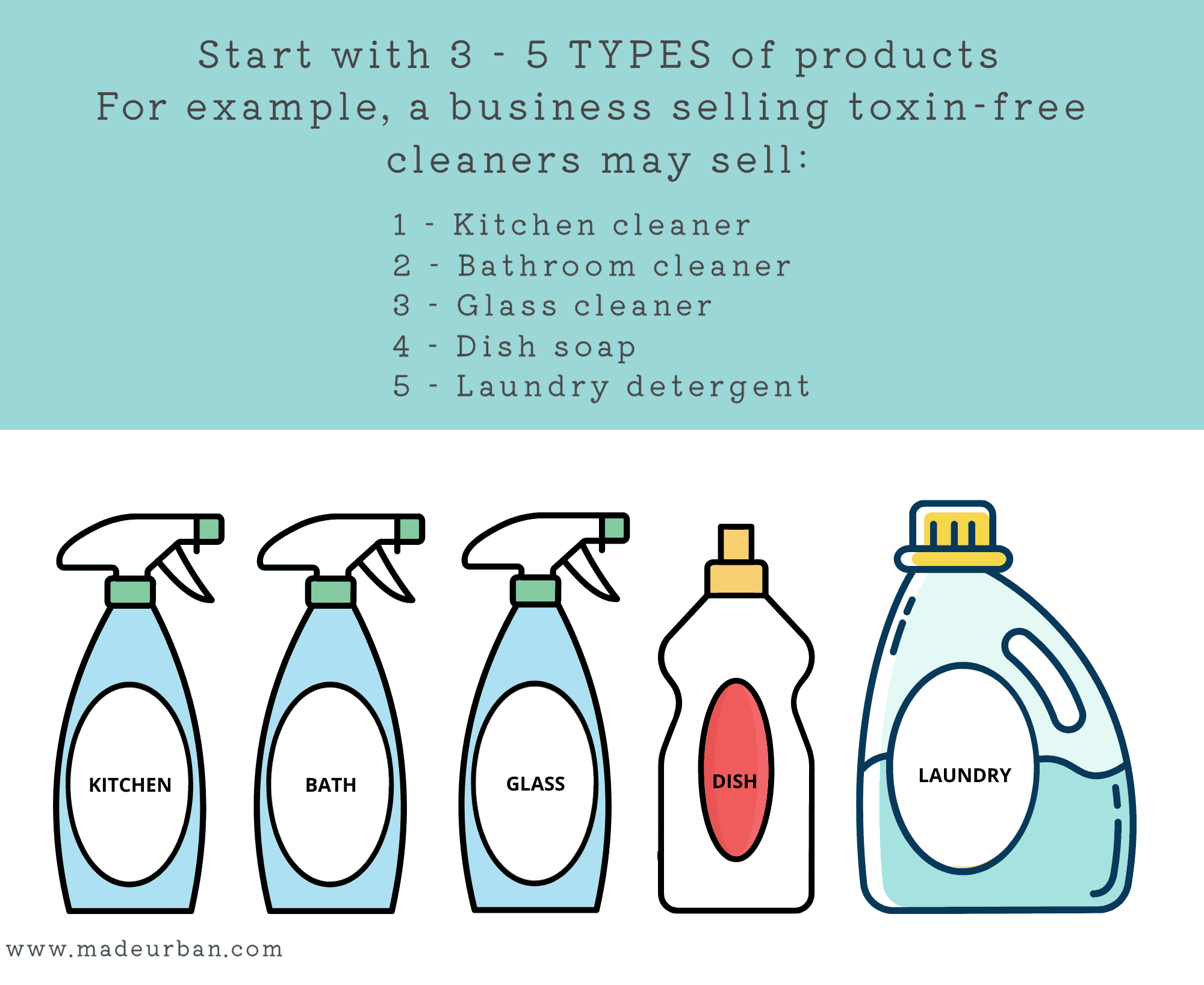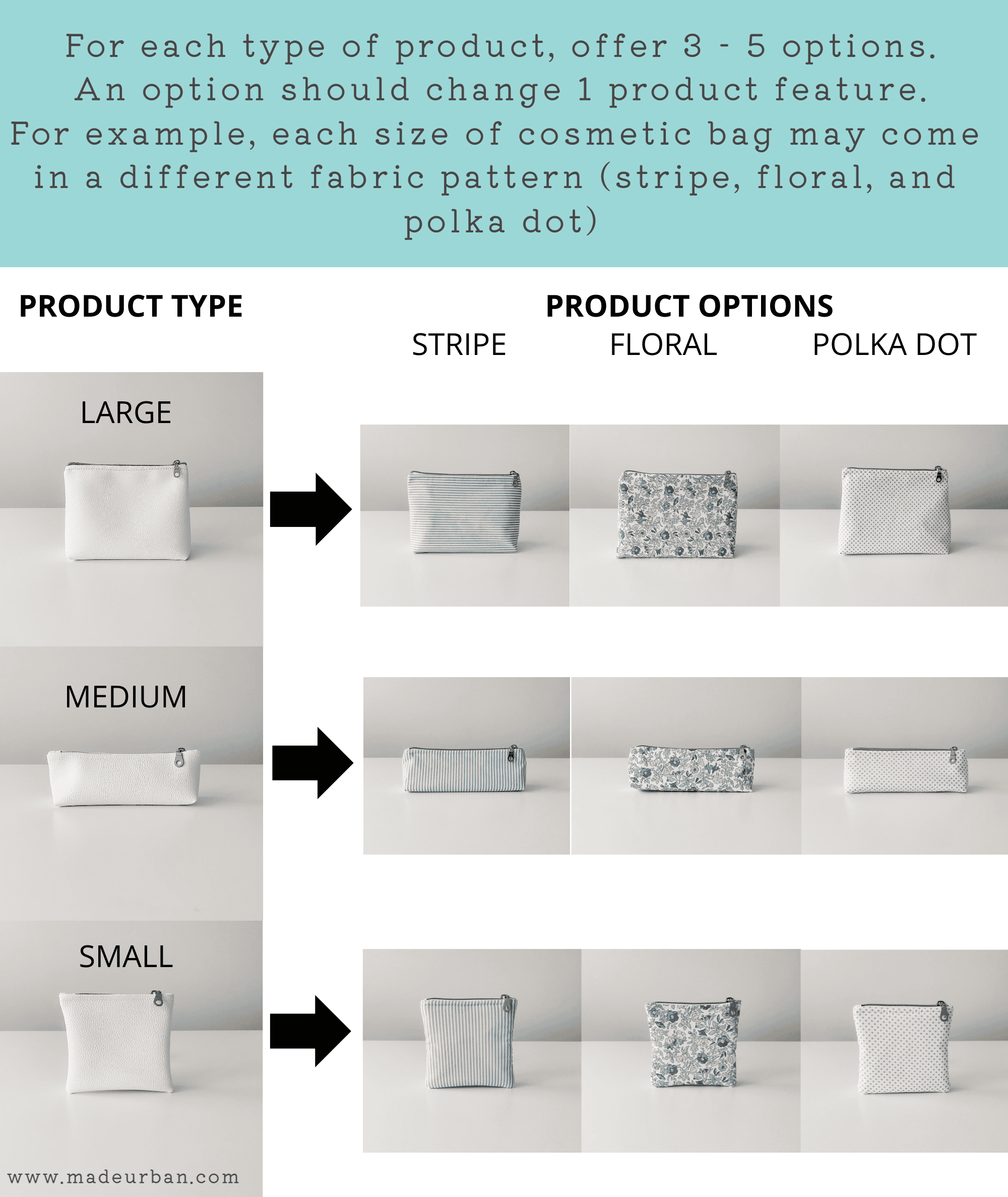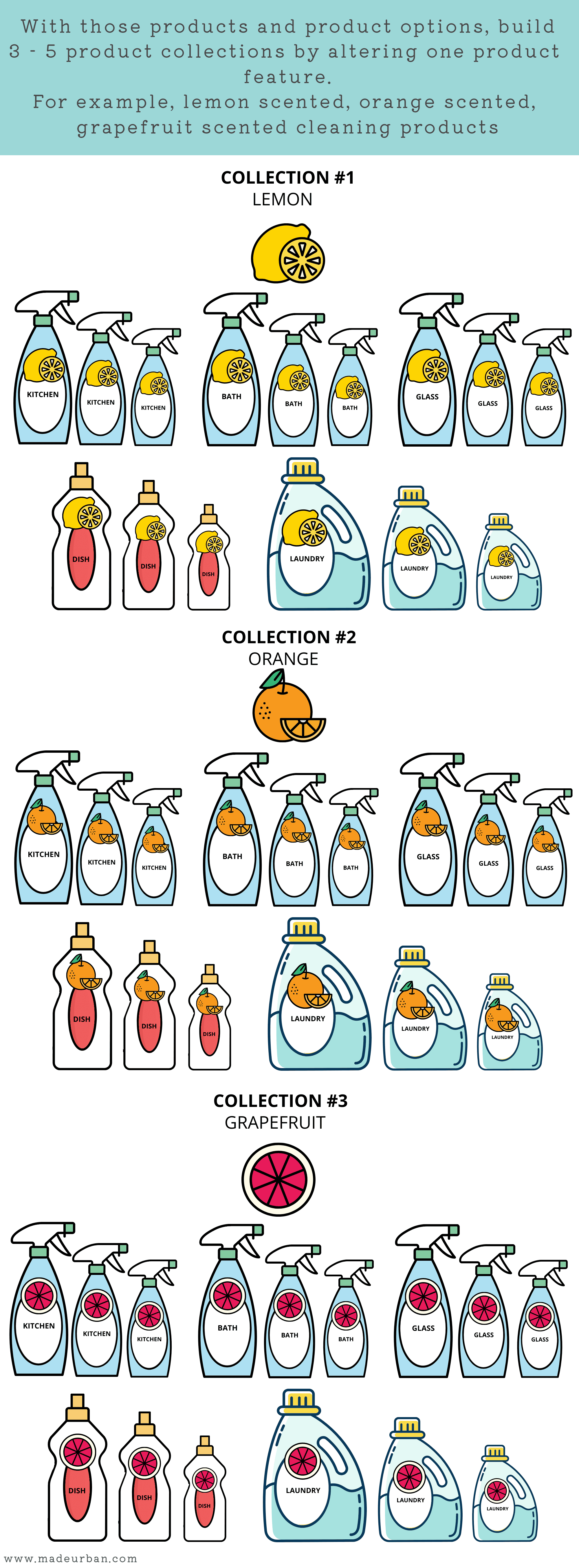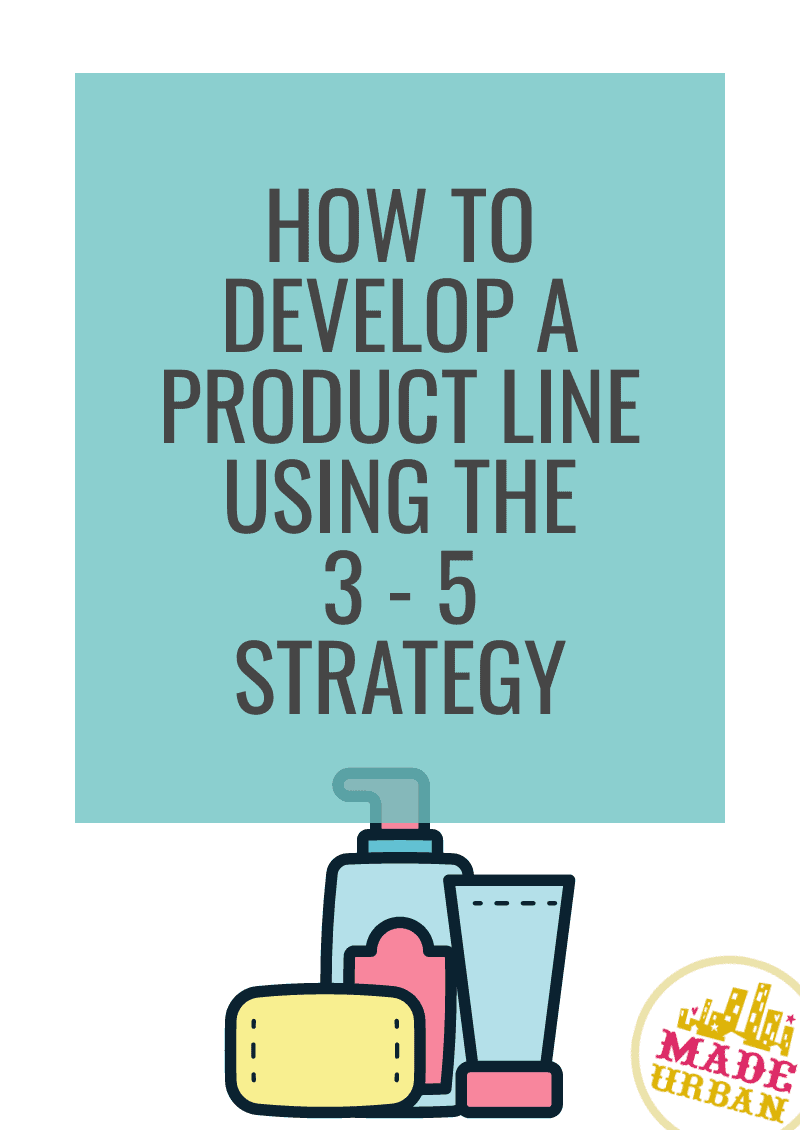How to Develop a Product Line Using the 3 – 5 Strategy
In my last article, How your Creativity is Killing Sales, I mentioned using a 3 – 5 guideline when creating your products, which helps ensure you’re not offering too much selection.
Sticking to this 3 – 5 strategy also helps ensure your product line stays cohesive.
This article is a detailed explanation of that strategy, sharing examples.
Who is this strategy for?
You may want to use this product development strategy if:
- You’re feeling overwhelmed with your product selection
- You’re a new business owner and don’t know which products to offer
- You have low UPT (units per transaction)
- You have a hard time matching colors/patterns
This strategy is a simple guideline to follow if you need to rein in your product selection but are unsure how.
Why you should limit your products
Reducing how many products you make and how much product variation you offer is a point I probably stress too much.
But that’s because it’s the number one problem I see most craft business owners struggle with.
It’s also the advice I get the most push back on.
“But I have tons of selection and my booth is always busy.”
I don’t doubt that.
Variation will attract shoppers. But a limited selection will turn more shoppers into buyers.
Studies have proven, an abundance of options has a negative impact on sales.
Too many product options can cause:
- Shopper overwhelm and decision fatigue
- Maker overwhelm
- Lower productivity and profits
- A disjointed display
- Lower sales and units per transaction
It’s important to remember, you’re a small business.
You need to specialize in something.
How to limit your products using the 3 – 5 strategy
The 3 – 5 strategy is a simple guideline to use when developing products, to ensure you’re not overwhelming yourself, or your shoppers with too many options.
As you establish your brand, streamline your business, and develop an understanding of which products your target market is interested in, you can expand.
But when starting your business and trying to determine your bestsellers, starting small is the way to go.
*Please remember, my advice is a suggestion. There isn’t a set rule or one way that works for every business. A business can be successful with one product or 20 products. But if you find yourself adding more and more to your product line in an attempt to sell to more people, you’ll find this strategy still offers a lot of options while staying focused.
Step 1: Start with One focus
Before you start building out your product line, it’s important to start with one purpose, theme, category/subcategory of products, niche, or target market.
This ensures your product line will stay focused and encourage multiple sales (i.e. one customer buying multiple items in one transaction and/or one customer coming back to buy again and again).
Examples are:
- Purpose: toxin-free cleaning products
- Theme: farm animal themed art work
- Category/subcategory: hair accessories
- Target market: Grandparents
- Niche: healing crystal jewelry
In most cases, a small craft business will need to use a combination to find an appropriate focus that helps their business stand out.
For example, if I choose a purpose, toxin-free cleaning products, that still leaves it open for a variety of products. I might offer facial cleansing products, shampoo/conditioner, home cleaning products, car cleaning products, etc.
So instead I might focus on:
- Purpose: toxin-free cleaning products + Category: home cleaning products = Toxin-free home cleaning products
If I’m just starting my business, I may even add another focus with a theme.
- Theme: fruit scents
This clear focus ensures I stay on track, build a name for my business, and carve out a niche that allows my business to stand out.
If I stay focused as I develop products, my customers can stay focused when they shop with me.
Step 2: Choose 3 – 5 Products
Keeping your focus in mind (i.e. your purpose/theme/category/etc), choose 3 – 5 main products you’ll work with.
These will be types of products, not variations of the same product.
For example:
If I’m selling toxin-free cleaning products, my 3 – 5 products might be:
- Kitchen cleaner
- Bathroom cleaner
- Glass cleaner
- Dish soap
- Laundry detergent

If I’m selling cosmetic bags, my 3 – 5 products might be:
- Small cosmetic bag
- Medium cosmetic bag
- Large cosmetic bag

If I’m selling healing crystal jewelry, my 3 – 5 products might be:
- Necklaces
- Earrings
- Bracelets
- Rings
Step 3: Choose 3 – 5 Product Options (optional)
Building out your product line into different options, is optional.
Not every product will need different options and depending on how many products you offer, adding 3 – 5 options in each may become overwhelming.
If you feel you need to expand your product line beyond 3 – 5 types of products, you can offer each in 3 – 5 options.
What an “option” is will depend on the type of product you sell.
An option will take one product feature, and alter it.
For example:
If I’m selling toxin-free cleaning products, product features are:
- size
- scent
- ingredients
- etc.
My 3 – 5 product options might focus on size and so I’d offer each product in:
- small
- medium
- large

If I’m selling a cosmetic bag, product features are:
- material
- color
- size
- shape
- etc.
I may offer each type of cosmetic bag in 3 – 5 material/print options:
- stripes
- floral print
- polkadot

If I’m selling healing crystal jewelry, product features are:
- metal (e.g. silver, gold, rose gold)
- stone (e.g. rose quartz, amethyst, etc.)
- healing property (e.g. courage, love, prosperity, etc.)
- style (e.g. pendant necklace, choker, etc.)
- etc.
I may offer each product in 3 style options:
- Necklaces:
- pendant necklace
- choker necklace
- layered necklace
- Earrings:
- hoop earrings
- stud earrings
- drop earrings
- Bracelets:
- stacked bracelet
- charm bracelet
- cuff bracelet
- Rings
- stacked ring
- wrapped ring
- solitaire ring
To avoid creating too much variation, stick to altering just one product feature.
Step 4: Create 3 – 5 Product Collections (optional)
Again, you can stop at offering 3 – 5 product types in 3 – 5 options. This will provide you with a good selection.
But if you want to build out your product line more, you can expand into collections.
A collection will include all your products and their options, but focus on a specific theme.
You can get creative with your collection’s theme, as explained in this article: 5 Steps to Create a Product Collection that Sells
Or you may simply base a collection’s theme on a product feature (e.g. material, color, scent, etc.).
For example:
A toxin-free line of products may have a:
- Lemon scented collection
- Orange scented collection
- Grapefruit scented collection

My cosmetic bag collections may be based on color:
- Pink collection
- Blue collection
- White collection
Each collection would consist of a small cosmetic bag in 3 material options, a medium cosmetic bag in 3 material options, and a large cosmetic bag in 3 material options.
A line of healing crystal jewelry may be based on the healing crystal’s meaning/energy:
- Love collection (using rose quartz and moonstone)
- Courage collection (using amazonite and aquamarine)
- Prosperity collection (using jade)
Step 5: Add-ons (optional)
If you feel too limited sticking to 3 – 5 products, consider branching out under the “add-on” category of products.
Add-on products are smaller/lower-priced items that will sit in your zone 3/checkout area and are easy for a customer to add to their purchase.
These shouldn’t take up much space on your craft show table, take too long for you to make, or distract shoppers from your main (3 – 5) products.
Add-on products should follow your product line’s focus.
It’s also a good idea to stick within the 3 – 5 range for your add-on products
For example:
Add-on products for a line of cleaning products might be:
- essential oil combinations for a diffuser
- dryer balls
- cleaning cloths
Add-on products for a line of cosmetic bags might be:
- scrunchies or headbands (for pulling back hair while doing makeup)
- reusable cotton rounds (for removing makeup)
Add-on products for a line of healing crystal jewelry might be:
- healing crystal keychains
- healing crystal pins
- healing cufflinks
These are all smaller items that could be made from leftover supplies and/or made for very little cost.
They’re also items that work with the main products, so customers are likely to add them to their purchase without hesitation.
Assess your product line
As you can see, staying within the 3 – 5 guideline offers a lot of variation for shoppers to choose from, while keeping your product line focused.
Cleaning product line:
>> 5 products in 3 options each and 3 collections = 45 different products for shoppers to choose from.
Bag product line:
>> 3 products in 3 options and 3 collections = 27 different products for shoppers to choose from.
Jewelry product line:
>> 4 products in 3 options and 3 collections = 36 different products for shoppers to choose from.
Please let me know in the comment section if you have any questions!


Hey, I’m Erin 🙂 I write about small business and craft show techniques I’ve learned from being a small business owner for almost 2 decades, selling at dozens of craft shows, and earning a diploma in Visual Communication Design. I hope you find my advice helpful!

Hi Erin, I have followed you from my handmade days to now, my vintage days. I apply many of your applications with much success, thank you. Can you please help me translate this to my current love of vintage/collectables. So Vintage/collectables would be my theme, my materials are wood, metals and glass, my colors are neutral wood, black, gold, silver, white and clear glass. how would I figure the 3-5 application to this? thank you Colleen
Hi Colleen,
Thank you so much for commenting! I’m so happy to hear you’ve found my advice helpful over the years 🙂
In the antique/vintage category, it will be a bit harder to stick to the 3 – 5 strategy since you don’t have full control over each product’s features; you’re at the mercy of what’s available/what you can find. I’m not as familiar with antique/vintage businesses but here are a few suggestions:
You may want to combine another focus with your theme, as “vintage theme” is pretty broad. I believe some people go “vintage shopping” and are open to buying anything and everything vintage, but I think more shoppers look for vintage furniture, or vintage clothing, or vintage bedding, or vintage living room decor during one shopping trip.
So you may want to start by getting more specific with the type of vintage products you sell.
You might niche down within the vintage theme (e.g. a specific era (60’s & 70’s) or style (e.g. art deco vintage) or focus on a specific purpose the vintage pieces serve (e.g. vintage kitchen and barware items).
Because you’re not making each item, it will be easier for you to offer more types of products, but try not to get too broad; stick to your focus.
Again, your product options and collections will depend on what you find, so I believe it would be harder to define options/collections first. But try to keep in mind what your target market cares about most when shopping for the products you sell, or when organizing them into options/collections. Do your shoppers care most about the style of the pieces, the era, the materials, the color, etc.?
I think if you get more specific with your focus (e.g. vintage art deco kitchen & barware) you won’t have to be as strict with the other steps, because your focus will keep your product line focused.
Then build product collections based on your findings. For example, if I found a lot of colored pieces, then I might have a pink collection, a blue collection, and an amber collection. If the next month I found a lot of crystal pieces, I would create a crystal collection.
I hope that helps!
~Erin
This was so helpful! I’m currently trying to rebrand a bit. I paint create Bible verse wall art. I also make cosmetic bags and totes and I also create oyster shell jewelry dishes. They are all centered around faith and Bible verses except for the jewelry dishes. I’m trying to get it down to a product line since I feel like my creativity is taking over. What would you recommend? Thanks!
Hi Shannon,
Although you have a theme, it sounds like it would be beneficial for you to focus on one category or subcategory of product. Either wall art, OR bags and totes, OR jewelry dishes. That first step will make it easier to complete the steps outlined in this article.
~Erin
By any chance, can you break this down for someone selling stationary or art as a calligrapher?
Hi Serina,
Here’s a quick example of how a stationery might be broken down using the strategy:
Step 1 – Because stationery is a fairly competitive category, you may want to narrow your focus down further. For example, you might focus on stationery for organization (checklists, to-do lists, weekly schedules, etc.) or targeting a specific market, such as gardeners.
Let’s say you create garden themed stationery.
Step 2 – Think of your 3 – 5 products as the categories you might have in your Etsy shop, that people can browse by. So that might be:
Greeting cards
Notepads
Notebooks
Stickers
Step 3 – Your 3 – 5 options might be based on gardening themes (e.g. succulent theme, flower theme, vegetable garden theme)
Greeting cards – succulent themed greeting cards, flower themed greeting cards, vegetable themed greeting cards.
Notepads – succulent themed notepads, flower themed notepads, vegetable themed notepads.
Etc.
That’s just one way to break it down, but it’s not the only way. If you only sell greeting cards, your 3 – 5 products (step 2) might be birthday cards, retirement cards, new baby cards, etc.
I hope that adds some clarity!
Erin
This is a VERY helpful article. Well written with great examples – especially the visuals. I can immediately see ways to unify my items. I’m going to read it again! Thank you so much.